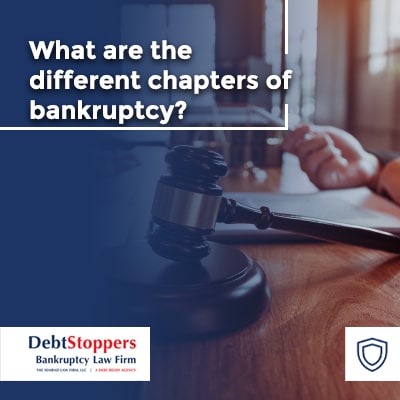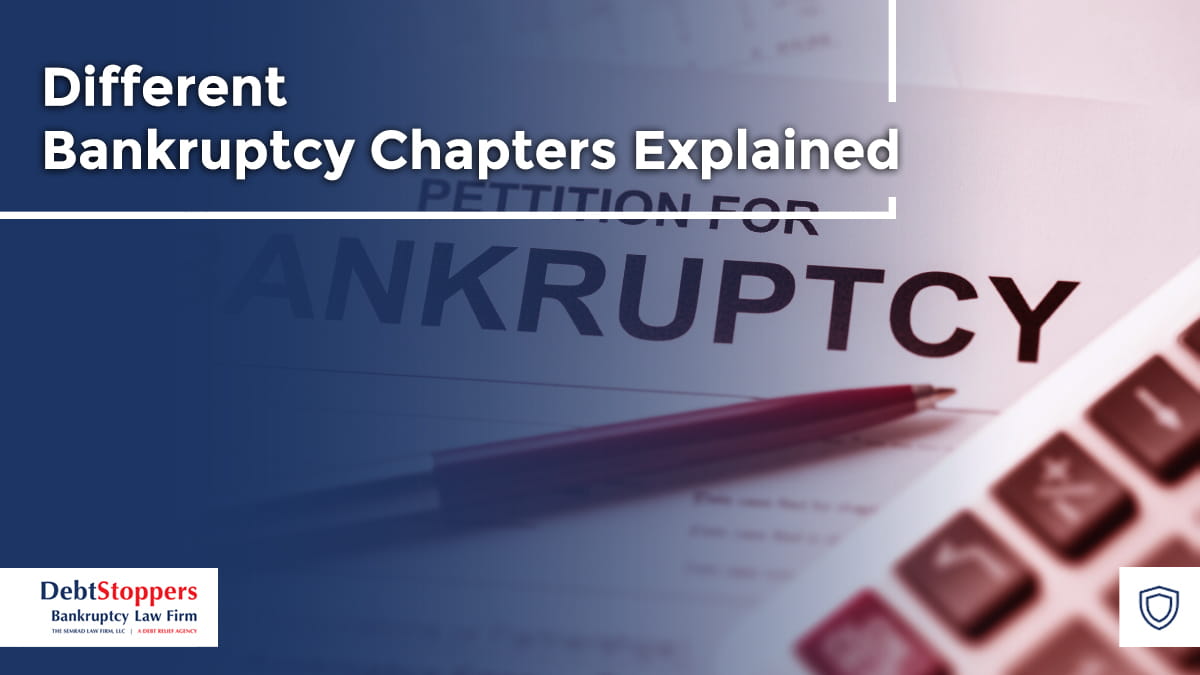If you’re considering filing for bankruptcy, it’s important to understand the different bankruptcy chapters so you can make an informed decision. The three main types of bankruptcy are Chapter 7, Chapter 11, and Chapter 13. Each chapter has different requirements and rules.
Ultimately, choosing the right chapter of bankruptcy will depend on your assets, types and amounts of debt, as well as your financial goals.
Bankruptcy is a legal process that people and businesses can use to discharge or organize their debt. Once debt is discharged through bankruptcy, you will no longer be required to repay the debt.
In the U.S., bankruptcy is governed by a set of federal and state laws. It’s important to know that laws vary by state, meaning that filing bankruptcy in Texas is different than Illinois.

What are the different chapters of bankruptcy?
In the US, there are six types of bankruptcy available; however, the most popular types of bankruptcy are Chapter 7, Chapter 11, and Chapter 13.
The vast majority of individuals who file bankruptcy utilize Chapter 7 or Chapter 13. Chapter 11 is often used by businesses while the remaining options are tailored for specific groups such as governments, farmers, and people with international issues.
Chapter 7
Chapter 7 bankruptcy is a legal tool that lets people discharge most unsecured debts, including credit card balances, medical bills, and personal loans. It is sometimes called liquidation bankruptcy and has a unique set of requirements.
When you file Chapter 7 bankruptcy, an automatic stay is immediately enacted, which temporarily halts collection actions from being taken against you. After you file Chapter 7 bankruptcy, the court will appoint a trustee to your case. The trustee will oversee your case, including the 341 meeting of creditors.
To qualify for Chapter 7 bankruptcy, you'll first be required to pass a means test. You are also required to complete two courses for Chapter 7 bankruptcy. Before you file, you are required to take the credit counseling course; after you file, you will be required to take the debtor education course. These courses must be completed before you can receive a discharge.
Ultimately, the bankruptcy court will issue a discharge order, which means you are no longer liable for the debts included in the bankruptcy. Typically, the process takes less than six months from filing to discharge.
Chapter 13
Chapter 13 bankruptcy lets people restructure their debt while keeping their assets. Chapter 13 bankruptcy is often used by people who have regular income and who can commit to making monthly payments for a period of three to five years.
After you file Chapter 13 bankruptcy, an automatic stay immediately goes into effect, and the court will appoint a trustee to oversee your case. Ultimately, the court will approve a repayment plan that will last three to five years. During the repayment period, you will make monthly payments to the trustee who will distribute the money to your creditors according to the court-approved repayment plan. After you have completed all requirements throughout the duration of the repayment period, your eligible remaining debt will be discharged.
Chapter 11
Chapter 11 bankruptcy is primarily used by businesses and sometimes people with an extremely high net-worth. Chapter 11 lets businesses restructure their debt and continue to operate while they address their debt. Sometimes high-income individuals with substantial debt file Chapter 11 if they exceed Chapter 13 limits.
Ultimately, the court will assess the assets and debts of the business and approve a repayment plan that addresses the debt over a set period of time while allowing the business to continue operating.
It should also be noted that Chapter 11 is expensive and involves extensive legal, accounting, and administrative costs. It’s also more complex than other types of bankruptcy. The process can be lengthy, especially for large companies with complicated debt structures. The success of a Chapter 11 reorganization depends on court and creditor approval, which isn’t guaranteed. If the plan fails, the business may need to convert to Chapter 7.
Other bankruptcy chapters
There are three other types of bankruptcy - Chapter 9, Chapter 12, and Chapter 15. Each of these types of bankruptcy has specific requirements. For example, Chapter 9 bankruptcy is utilized by government units like cities and towns. Chapter 12, on the other hand, is specifically for family farmers and fishermen. Chapter 15 is typically reserved for cases that involve international issues.

How to choose the right bankruptcy chapter for you?
Choosing the right bankruptcy chapter is critically important. Each type of bankruptcy has unique rules that govern who is eligible and what debts can be discharged.
To choose the right bankruptcy chapter, it’s important to understand your options. Since bankruptcy law is complex and can vary from state to state, it’s wise to consult with a bankruptcy attorney to discuss your situation. Most bankruptcy attorneys will provide a free consultation where you can review your debt, assets, and your short and long-term financial goals.
While it is possible to change after you file, it will take more time and money, so it’s important to make an informed decision.





